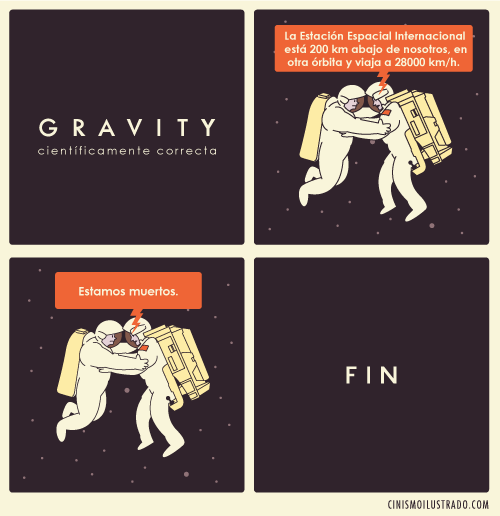
Total Pageviews
Wednesday 23 October 2013
WiLAN loses lawsuit against Apple over cellular data patents

You can use your real name on PlayStation 4 at launch, but aliases are OK too

El carguero Cygnus termina su primera misión a la Estación Espacial Internacional
We have lost the signal from #Cygnus. Reentry accomplished. Represents the official completion of our COTS program with @NASA partners
— Orbital Sciences (@OrbitalSciences) October 23, 2013
Tras 35 días, 3 horas, 18 minutos y 27 segundos la primera cápsula de carga Cygnus de Orbital Sciences ha terminado su misión desintegrándose en la atmósfera llevando en su interior materiales de desecho de la Estación Espacial Internacional después de haber dejado allí 731 kilos de carga.
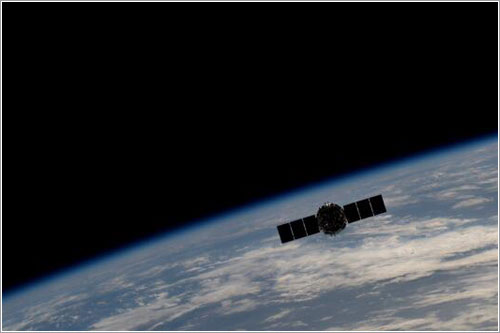
La Cygnus alejándose de la EEI
Se trataba de la misión para certificar a la Cygnus para que pueda realizar vuelos de suministro a la EEI y dado que todo ha ido bien salvo un pequeño problema inicial con los datos GPS que enviaba la Estación al sistema de navegación de la cápsula que se arregló con una línea de software todo está listo para que la próxima Cygnus lleve ya a cabo la primera misión regular a la Estación.
Esta próxima Cygnus llegaba hoy, casualmente, al centro de lanzamiento para ser preparada para esta próxima misión.
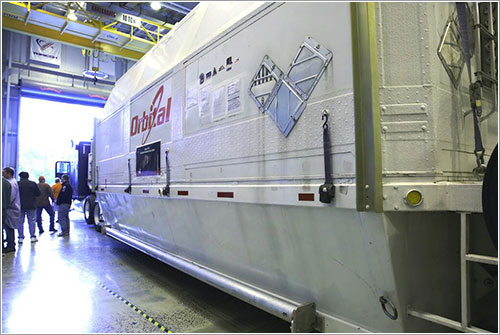
Llegada de la segunda Cygnus al centro de lanzamiento
Con la Cygnus y la Dragon, que lleva ya cuatro misiones completadas, los Estados Unidos dependen ya menos de disponer de espacio en naves de carga como otros países como los ATV de la ESA, las Progress rusas, o los HTV de la Agencia Japonesa de Exploración Aeroespacial.
Tanto la Cygnus como la Dragon han sido desarrolladas bajo loas auspicios del programa de Servicios Comerciales de Transporte Orbital, una programa de la NASA para que empresas privadas lleven carga, y se espera que en breve, tripulantes a la EEI.
- Las once pruebas de la cápsula de carga Cygnus, los pasos a seguir para poder atracar en la Estación.
via Microsiervos http://www.microsiervos.com/archivo/ciencia/carguero-cygnus-termina-primera-mision-estacion-espacial-internacional.html
Careful, Hunters: PETA's Drones May Be Watching You

622 megabits por segundo desde la Luna vía láser
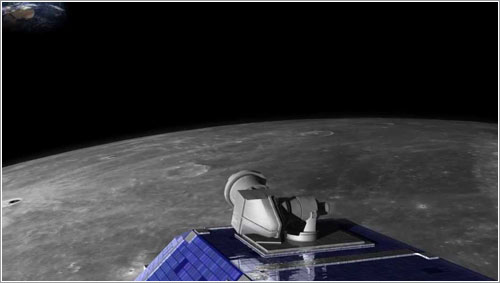
El transmisor láser del LLCD va montado en el exterior de la LADEE de forma que puede pivotar para apuntar a la Tierra
La sonda LADEE de la NASA tiene como misión principal estudiar la extremadamente tenue atmósfera de la Luna, que de hecho es una exosfera, formada por moléculas que flotan alrededor de ella que no pueden escapar al espacio porque la gravedad de nuestro satélite se lo impide pero que son tan escasas que no se comportan como un gas.
Pero además lleva a bordo un sistema de comunicaciones por láser conocido como LLCD, Lunar Laser Communication Demonstration, que la NASA quería probar como alternativa a la tradicional transmisión por radio, que en muchos casos está ya un poco al límite de su capacidad debido a la enorme cantidad de datos que pueden generar los satélites y sondas actuales.
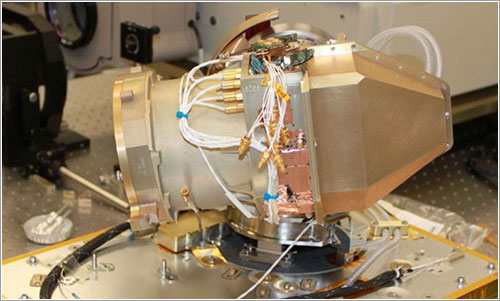
Transmisor láser de la LADEE
Y según se puede leer en NASA Laser Communication System Sets Record with Data Transmissions to and from Moon las primeras pruebas han conseguido ya transmitir datos desde la Luna a las estaciones receptoras en la Tierra a una inusitada velocidad de 622 megabits por segundo.
Esta velocidad fue alcanzada con la Luna alta en el cielo; con ella más baja sobre el horizonte la velocidad bajó a la mitad, pero eso era de esperar, ya que hay más atmósfera que atravesar.
Los 622 Mbps representan una velocidad cinco veces superior a la máxima obtenida hasta ahora en transmisiones desde la Luna, y mucho mayor que la que algunos pueden tener en sus casas se pongan como se pongan.
Las mismas pruebas han conseguido enviar datos desde tierra a la LADEE a 20 Mbps.
Sin embargo el LLCD es solo una demostración de que es posible usar un sistema como este para comunicarse con naves en el espacio y de hecho la misma LADEE usará un tradicional transmisor de radio de banda S para enviar los datos que obtenga con sus instrumentos.
El siguiente paso será el Laser Communications Relay Demonstration, que en 2017 se espera que sea capaz de recibir datos a 1,25 gigabits por segundo desde una estación terrestre y retransmitirlos a otra.
Además, a diferencia del LLCD de la LADEE, se espera que el LCRD esté en funcionamiento las 24 horas del día durante entre dos y cinco años.
Con el tiempo, la idea es utilizar comunicaciones láser como estandar.
Pero mientras tanto tendremos que esperar a que los datos de la New Horizons nos lleguen a una velocidad similar a la de un modem de 14K, aunque 5.000 millones de kilómetros de distancia y un emisor de 15 watios no dan para más.
via Microsiervos http://www.microsiervos.com/archivo/ciencia/622-megabits-por-segundo-desde-la-luna-via-laser.html
gdgt's best deals for October 23rd: Canon VIXIA HF-G10, Klipsch Synergy S-10 speakers

BBC and Twitter join forces to embed original videos in promoted tweets (video)

Google Glass project tackles poverty, other real world problems

How to Do a Clean Install of OS X Mavericks

Por fin, una versión de Gravity científicamente correcta
Esta versión de Gravity científicamente correcta de Eduardo Salles lo clava en cuatro viñetas, y además no contiene spoilers si has visto los trailers.
No te pierdas tampoco la parodia en 8 bits de Gravity.
Y es que yo, como espaciotrastornado, tengo muchos problemas con esa película, claro que alguien más normal seguro que la disfruta enormemente.
(@sallesino vía @papadzulero).
via Microsiervos http://www.microsiervos.com/archivo/humor/por-fin-una-version-de-gravity-cientificamente-correcta.html
Insert Coin semifinalist: BITalino is a self-contained physiological tinker lab

Apple's Making of the Mac Pro Video Is Pure Tech Porn

Nintendo's new Wii U Deluxe Set includes Mario games, ships November 1st for $300

T-Mobile offers 200MB free monthly data for all tablets, will carry Nexus 7 in-store on November 20th

Yahoo Acquires Startup LookFlow To Work On Flickr And ‘Deep Learning'

LookFlow, a startup that describes itself as “an entirely new way to explore images you love,” just announced that it has been acquired by Yahoo and will be joining the Flickr team.
The company writes on its homepage, “Fret not, LookFlow fans. Keep an eye out for our product in future versions of Flickr — with many more wonderful photos and all that Flickr awesomeness!” It also says it will be helping Yahoo to form a new “deep learning group.”
When I emailed Yahoo for confirmation, a company spokesperson told me, “We have acquired LookFlow, an enhanced image recognition company,” and they pointed me to the aforementioned LookFlow homepage.
I wasn’t able to find much information about LookFlow online, but according to the LinkedIn profiles of its co-founders Bobby Jaros and Simon Osindero, the company was founded back in 2009. Osindero wrote, “Our approach integrates recent developments from artificial intelligence, information visualization, and interface design.”
The acquisition message also thanks “friends of LookFlow” including Michael Dearing, John Lilly, Reid Hoffman, Alex Rampell, Josh McFarland, Max Ventilla, and Jeff Hammerbacher — I’m guessing at least a few of them invested in the company. (Hammerbacher is listed as an investor on LookFlow’s AngelList profile.)
Yahoo has been famously acquisitive since Marissa Mayer took over as CEO last year. The company reported that it spent $163 million in cash on acquisitions in the last quarter. And back in August, it announced that it was acquiring image recognition startup IQ Engine, also for Flickr.
The financial terms of the deal were not disclosed.
via TechCrunch » Startups http://feedproxy.google.com/~r/techcrunch/startups/~3/Tea7h-fL_3Q/
Insert Coin semifinalist: HeadsUP is a smartphone-powered HUD for your car

LinkedIn unveils new iPad app with a fresh look, improved feed and better search

Keen IO Raises $2.35M For Its Custom Analytics Platform

There are lots of analytics services out there, but what if they don’t give you the exact information that you’re looking for? Well, you could build your own system from the ground up — or you could use Keen IO, a startup that recently raised $2.35 million in new funding.
The company describes itself as “the API for custom analytics.” Basically, it offers tools via an API that developers can use to build their own analytics products. Keen IO can supposedly help customers gather data from any source, store it, and visualize it in any way that they want.
Co-founder and CEO Kyle Wild said he’s not trying to compete with products like Google Analytics. (In fact, Wild said his first job out of college was as a “developer success” consultant with Google Analytics.)
“You can’t rely on out-of-the-box parts for everything,” Wild said. “One of my favorite examples is a smartwatch. No one’s ever going to make an out-of-the-box smartwatch analytics product. It’s just too fragmented.”
He added that some Keen IO customers sign-up when they’re thinking about building their own analytics system and they realize it’s “faster to build it on us, and more future proof and robust and cheaper, at least in the beginning.” Others, meanwhile, have already built their own system: “They come to us when it starts to break.”
To illustrate what Keen IO can do, Wild said that building a system for tracking conversion funnels is difficult (“funnels are hard”), but using the API, a developer could create a funnel with some simple code. (You can see code samples of Keen.io implementation on the company’s front page.) It says customers can also upload historical data, access new data in real-time, and white label the service for their own customers.
Wild also emphasized that Keen IO can scale to large amounts of data, and that the company aims to be transparent about the different technology it uses — “a lot of the meat,” he said, comes from Storm, an open source system for real-time computation.
Keen IO launched a beta version last year, and it started charging customers in April. The company is already “approaching profitability pretty rapidly,” Wild said.
The funding, which Wild described as an additional seed round (Keen.io previously raised $750,000 in seed funding), was led by Amplify Partners and Rincon Venture Partners. Pelion Venture Partners also invested, as did previous backers 500 Startups, XG Ventures, Jason Seats, and Loren Siebert.
“Keen IO has all of the attributes we look for in a company: a passionate, expert founding team; a sound scalable business model; big market tailwinds; and a compelling customer value proposition,” said Rincon’s Jim Andelman in an emailed statement. “As a testament to market receptivity, we introduced the company during our evaluation to four prospective customers in SaaS and Ad-tech, and every single one of them plans to use the service.”
via TechCrunch » Startups http://feedproxy.google.com/~r/techcrunch/startups/~3/4VXgmEiVuQw/
LinkedIn intro puts the power of LinkedIn directly into your iOS email inbox

Engadget's 2014 Best of CES Awards: Eligibility criteria and how to nominate

LG Reveals the Fireweb, Its First Firefox Smartphone

Bell to track Canadian users' internet, phone and TV habits for targeted ads

Academia.edu Crosses 5M Users And Acquires Plasmyd, A Search Engine For Research Papers

Academia.edu, a social networking platform for academics that’s looking to change the way scientific research is shared, just acquired Plasmyd, a search engine and discussion platform for research papers.
It’s all part of CEO Richard Price’s plan to change the way peer review is done online. Plasmyd has more than 60 million papers indexed and every page has its own research abstract and an area for comments.
He’ll retire Plasmyd’s brand and incorporate their search engine and commenting system into Academia.edu’s platform. He’s bringing on the bootstrapped company’s two founders into Academia.edu for a mix of stock and cash. (Incidentally, Price first learned about them on TechCrunch!)
His belief is that opening discussion of research to a broader audience beyond the handful of reviewers that a typical scientific journal handpicks will allow both errors and high-quality work to get surfaced faster.
He pointed to a recent sting operation by Science where a researcher sent 304 versions of an error-ridden paper to dozens of open access academic journals. One hundred and fifty seven of the journals accepted the paper with only minor modifications.
In a typical journal review process, Price says the editor operates like a “human routing function” that sends papers to relevant academics in their personal network. Those academics check for basic theoretical coherence and whether the methods look reasonable. They don’t try to replicate the results of an experiment because that is often too costly.
“The second phase of open science will be about making peer review more robust over the next few years,” Price said.
As for Academia.edu itself, they just crossed 5 million registered users, which makes them larger than competitors like Benchmark-backed ResearchGate and Mendeley, which was recently acquired by research giant Elsevier.
Oh, and they also recently picked up a $11.1 million growth-stage round led by Khosla Ventures.
via TechCrunch » Startups http://feedproxy.google.com/~r/techcrunch/startups/~3/5JBsTqHPtBE/
Samsung Galaxy S4 Mini coming to four US carriers in November

Vudu teams up with Sony to offer extra streaming features

¿Dónde está mi coche volador? Aquí, más o menos
Vale, no es el coche volador que se suponía que tendríamos en el futuro pero es algo: el Aeromobil 2.5 por ahora es otro prototipo —con pocas posibilidades de convertirse en realidad y muy poco práctico— de coche que puede levantar el vuelo.
Aunque no parece muy allá ni como coche ni como aeronave el vídeo mola, y aún mola más que no decaiga el ánimo.
via Microsiervos http://www.microsiervos.com/archivo/tecnologia/donde-esta-mi-coche-volador-aqui-mas-o-menos.html
